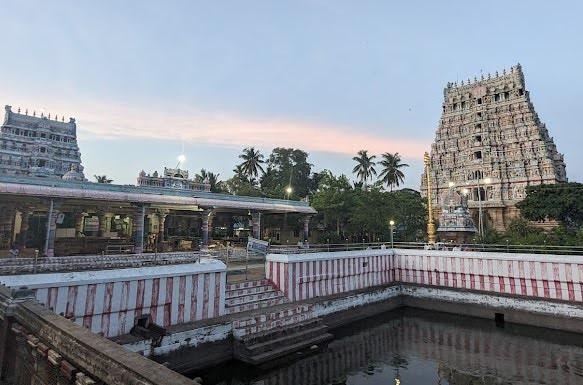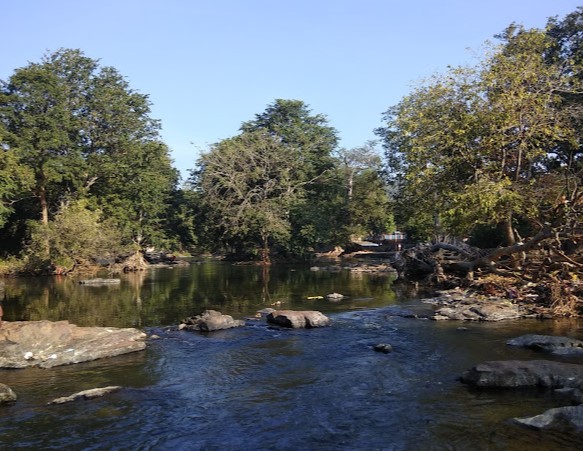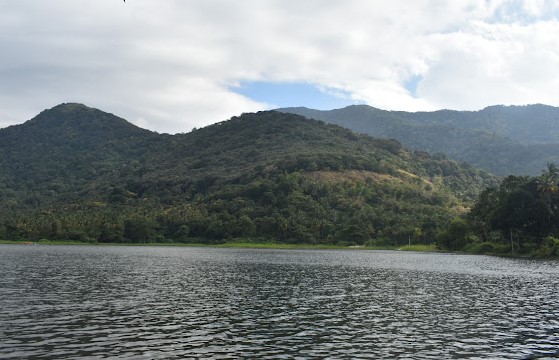- This is one of the 276 Devara Paadal Petra Shiva Sthalams and 23rd Shiva Sthalam on the Southern bank of the river Cauvery in Chozha Nadu (Thenkarai).
- This Temple is considered as one of the shrines of the 276 Paadal Petra Sthalams glorified in the early mediaeval Thevaram hymns.
- This Temple is the 140th Devara Paadal Petra Shiva Sthalam and 23rd Sthalam on the south side of river Cauvery in Chozha Nadu. Lord Shiva in this temple is a Swayambumurthi (self-manifested).
- This temple is very famous for Goddess Durgai and is popularly known as Durgai Amman temple.
- This east facing temple has 3 corridors and its main tower (Rajagopuram) has 7- tiers.
- Dhenupureeswarar Temple is a Hindu Temple dedicated to Lord Shiva located in Patteeswaram in Kumbakonam Taluk in Thanjavur District of Tamil Nadu.
- Presiding Deity is called as Dhenupureeswarar / Patteeswarar and Mother is called as Palvalai Nayagi / Gnanambigai.
PURANIC SIGNIFICANCE:
The legend is that Patti, the daughter of the divine cow Kamadenu, worshipped the lord here. Hence this place gets the name Patteecharam (“Echaram” means temple in Tamil). The lord is praised as Sri Patteeswarar (Sri Thenupureeswarar in Sanskrit).
Patteeswaram:
As per legend, Mother Parvathy chose this place for her penance on Lord Shiva. Devas came here and resided in the form of trees and plants to protect her. They made the surroundings greener to make Mother Parvathy comfortable in performing her penance. Kamadhenu deputed her daughter Patti to support Mother Parvathy in her penance. Pleased with Mother Parvathy's penance, Lord Shiva appeared here with his long uncombed hair (Sadai Mudi) and provided darshan. Thus, Lord Shiva assumed the name Kabartheeswarar.
Knowing the sacredness of the place and observing the Shiva puja by Mother Parvathi, Patti too made a Shivalinga of sand and performed penance here. It took water from the sacred Gnanavavi Theertha for abhishekam. All merciful Lord Shiva approved Patti’s sand Linga and merged in the same and made it all sacred. As the Patti calf worshipped here, the place came to be called Patteeswaram and Lord came to be called as Patteeswarar / Dhenupureeswarar.
Thiru Gnana Sambandar’s Patteeswaram Trip:
Thirugnana Sambandar came to Thirusakthimutram with Adiyars (saints) to worship Lord Shiva at Thirusakthimutram Sakthivanesvara Temple. Then he started towards Patteeswaram. As it was peak summer, the child Sambandar could not manage. The Lord sent his Boodhaganas (servants) to decorate the streets with a beautiful Muthu Pandal (ceiling made of flowers). The Boodhaganas prepared the Pandal without Sambandar's knowledge. Sambandar was astonished by the reverence of God and enjoyed the shade offered.
When he was about to enter the temple with his disciples, Dhenupureeswarar asked his Nandi to give way to Thiru Gnana Sambandar so he could watch the poet’s grand entry thus providing him darshan right from the entrance. Hence to this day, the Nandi at the temple is seen slightly to the left and not directly opposite Dhenupureeswarar. In memory of this event, the Muthu Panthal Festival is celebrated at this temple in a grand way every year in Aani.
Lord Rama’s relief from Chaya Hathi Dosham:
After defeating Ravana, it is believed that Rama visited Patteeswaram to liberate him from Chaya Hathi Dosham that had struck him for having killed Vaali by striking an arrow from hiding. This event is celebrated every year during the Tamil month of Margazhi. He installed Shiva Lingam here at Patteeswaram, one of the three places in Tamil Nadu where he did this, the other two being Rameswaram and Vedaranyam. He also created a well and used the water to perform abhishekam to Lord Shiva. This well came to be called Rama Theertham / Kodi Theertham. This Theertham is considered equivalent to Dhanushkodi Theertham.
Dharma Sharma, disciple of Medhavi Rishi, liberation from curse:
Medhavi Rishi of Malava kingdom left his ashram to attend a yagna conducted by Sage Pradesas. He assigned his disciple Dharma Sharma to take care of the Ashram and the cows. On his return, he found that the cows had become weak, significantly impacting their ability to deliver milk. An angered rishi cursed him to become a dog. To liberate himself from the curse, Dharma Sharma, now in the form of a dog, came here to the South of Cauvery to Devi Vanam. When the sacred water fell on the dog, he was liberated from the Sage’s curse and regained his original form.
10 days Thai festival:
King Chitra Sena of Kaambeeli had no child. To liberate himself from the sins of the previous birth, he came here with his wife and undertook a bath in the sacred tank. He performed Putra Kameshti Yagna here. Pleased with his prayers, Lord Shiva appeared before him in Vaikasi and blessed him with a child. As a thanks giving to the Lord, a delighted king started the grand 10 days festival in Thai.
Sage Vishwamitra received his title Brahma Rishi here:
Legend says that Sage Vishwamitra was enlightened with the Gayathri Mantra in this place and received his title Brahma Rishi by Sage Vasishta here. The Gayatri Theertham is believed to have been created by Sage Vishwamitra.
King Sakthiyumna got relief from Brahmahathi Dosham here:
King Sakthiyumna was afflicted with Brahmahathi Dosha. He went to Sage Kashyapa for relief from dosha. He was advised by Sage Kashyapa to visit this temple for relief. As advised, he visited this temple, took bath in Gnanavavi Theertham and worshipped Lord Shiva. It is said that a parrot taught him the Panchakshra mantra in this Temple. Once he learnt the mantra, he was relieved from his dosha.
Sage Markandeya worshipped Lord Shiva here:
It is believed that Sage Markandeya worshipped Lord Shiva of this Temple.
Goddess Durgai Temple:
Goddess Vishnu Durgai’s shrine, located at the northern entrance of this temple, is very popular among devotees. This temple is also known as Durgai Amman temple.
The Chola kings including the great Rajaraja Chola were staunch devotees of Goddess Durgai. She was the protecting deity of the Cholas in their fort’s northern gate. After the decline of the Chola empire, the idol of Durgai from their fort was installed in this temple. She is also known as “Sri Kottaivayil Durgai”.
The Goddess here is known by many names such as Vishnu Durgai, Durga Lakshmi, Navayoga Nayaki, Navakoti Nayaki, Navagraha Nayaki, Navaratri Nayaki and Navasakthi Nayaki, to name a few. Unlike in other temples, Goddess Durgai here has a pleasing appearance (“Shanta Swarupi”). She appears in a Thribanga stature - with eight hands, three eyes, wearing earrings (“kundalam”) and standing on top of the demon Mahishasuran. Generally, her mount (lion) looks towards the right side whereas here it faces left.
Temple Administration
The temple is under the administration of the Hindu Religious and Charitable Endowments Department of the Government of Tamil Nadu. Historically, the area was known as Mazhapadi, Patteecharam, Devivanam, and Shaktivanam, and it was once the capital of the Chola Kingdom.


